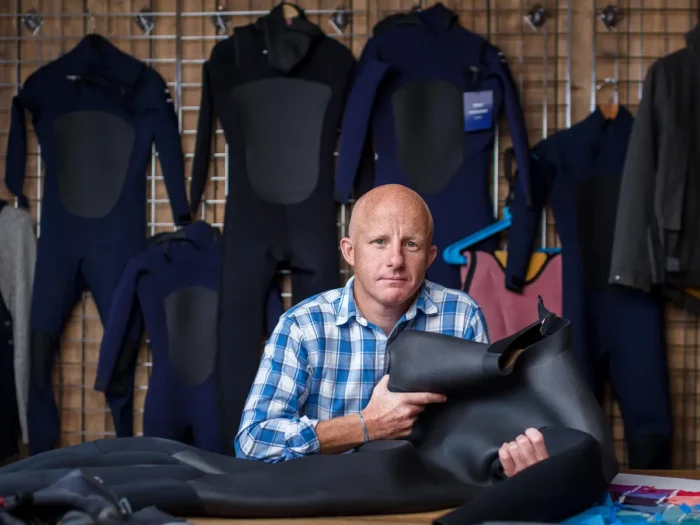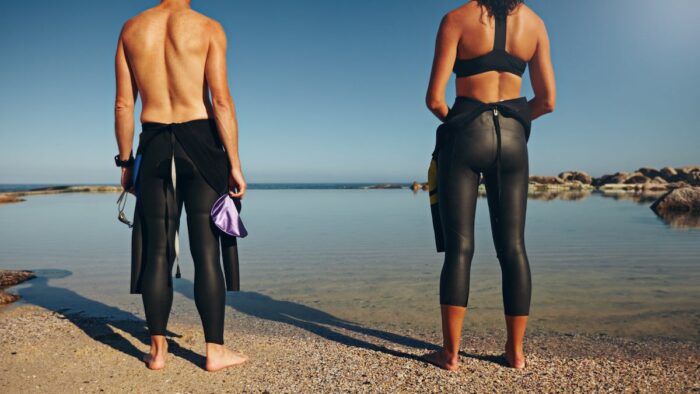
It’s a common question that gets asked by many people who don’t surf. The short answer is that surfers wear wetsuits to keep themselves warm in colder waters.
In this article, we’ll unpack the topic in more detail. We’ll look at wetsuit dynamics, the benefits of wearing a wetsuit, and the drawbacks.

How Does A Wetsuit Work?
Wetsuits keep surfers and other swimmers warm by warming the thin layer of water that sits between the inside of the neoprene and your body. When a wetsuit admits this water, your body temperature will gradually raise the temperature of the water over a few minutes.
Wetsuits generally imply a somewhat more relaxed start, but things warm up from there. As you move around, the water then adapts to your body temperature.
They are tight-fitting and can keep only a small amount of water in. They also cling to you tightly, keeping your body heat safe.
Suits are a fantastic example of engineering and innovation, which means that watersports enthusiasts such as surfers can truly accomplish things that would be impossible without them.
Why Are These Black?
Wetsuits are almost always black since this color helps retain more solar energy, keeping the surfer warm. They’re also black because most neoprene is typically produced in black, which aids in cost savings.

What Are The Advantages Of Surfing In It?
The three significant advantages of wearing a suit when surfing are:
- Warmth
- More time in the water
- Enables you to surf all year round
They provide warmth, allowing surfers to surf dynamically. Consider plunging into an ice bath versus a mild, somewhat warm bath, and you’ll see that extremely chilly water can make you tense up and lose much of your flexibility.
However, if you wear a suit when the water temperature is lower, your body can keep more heat. This enables you to surf freely and attempt new tricks.
These enable surfers to stay in the sea for longer, which is always a plus if you want to enjoy as much time in the water as possible without feeling chilly and damp. They also allow surfers to venture outside in locations and climates that would otherwise be impossible.
Wetsuits for surfing were only developed in the late 1970s, before which people couldn’t even try surfing throughout much of the winter season across the world. Today, surfers are surfing all around the globe, 24 hours a day, seven days a week, 365 days a year. This is thanks to their wetsuits and the development and improvements in them.
These have also allowed surfers to ride waves in places near and far where water temperatures are too low for conventional surfing.
Click here and learn more about wetsuits.

Wetsuit Material And Construction
These are made from neoprene, a stretchy synthetic rubber material. The wettie (you like that cool surfer speak?) is made out of several of these pieces of neoprene stitched together to cover the desired body parts. Wetsuits come in many forms, including shorties (the wetsuit has short legs and arms) and full suits; some even have detachable arms and legs.
The neoprene of these suits comes in different thicknesses, from 2 to 6 mm. The thicker the neoprene is, the warmer the suit will be. Note that some surfers who brave icy conditions usually wear a semi-dry suit, which isn’t made out of neoprene at all. Now they contain heating elements.
Your average suit will have a zip, making it easier to get in and out. This can be the most exhausting part of your day with an exceptionally tight suit! The zips are situated in different places on the suit. They’re traditionally found down the back of the wetsuit, but they can also be found across the shoulders or high up on the chest. The latest ones are such stretchy neoprene that you can get in through the neck. Pretty cool stuff.
Stitching And Sealing
It can be sealed together in various ways, depending on the wettie’s design. Some different methods of stitching and sealing are blind stitching, taped, glued, flat locked, and heat sealed. Interesting, isn’t it? Anyway, what type of diving suits you wear depends on the conditions you will be surfing in.

Are There Any Disadvantages To Surfing In A Wetsuit?
Owing to their tight fit and ability to absorb water, these suits make movement more difficult. These features render surfing less pleasurable in all situations, as we’ll see below.
Wetsuits are made from neoprene panels stitched and glued together to form a human figure. The neoprene must be at least 1mm thick to function as a wetsuit, with winter surfing or “steamers” requiring up to 6mm thickness. The heavier a surf suit is, the less flexible it becomes. As you can imagine, the thicker a surf wetsuit is, the heavier and less flexible it becomes.
These are also not recommended because they are thicker in colder waters, but the cold causes your body to struggle to move more, so it’s a double punishment for your suit and your body’s response to the chilly water.
Wetsuits not only retain water, but they also absorb it by design. A wet wetsuit can double in weight. This has much more of a feel of wearing a weighted vest for resistance training than simply wearing a bodysuit!
With this in mind, you may infer that surfing with a wetsuit reduces the dynamic motions required for surfing waves and necessitates more work for the surfer wearing one.
However, this is often a necessary compromise for surfers in colder climates who cannot surf due to the weather. Due to the freezing temperatures, many would watch from the beach without a wetsuit.
Conclusion
Buying a new wetsuit can be a fun experience. It can take some time to sort through all the information, but all the research and effort will be worth it when you are chasing waves in your brand-new wetsuit!











